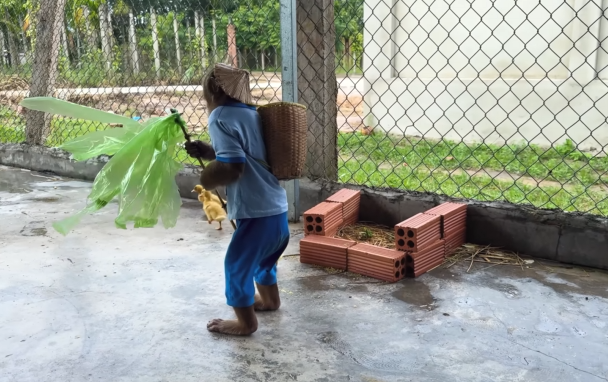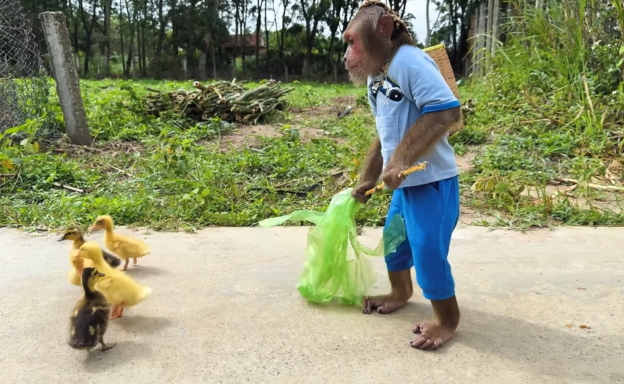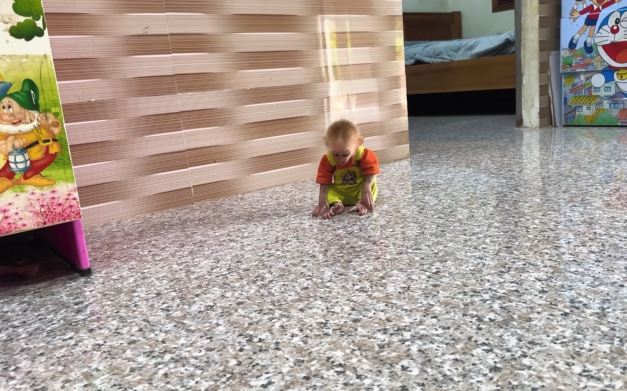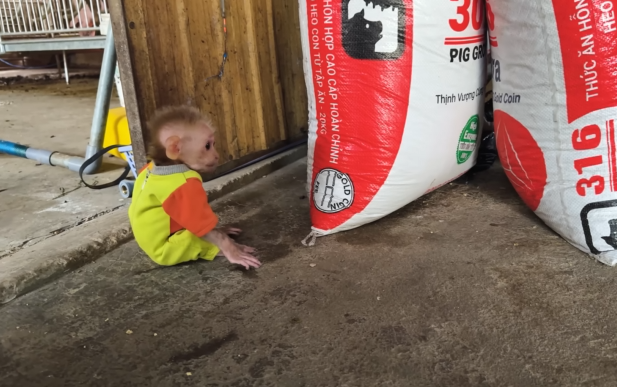







It was a bright and peaceful morning on the charming CUTIS farm, nestled in the lush green countryside. Birds chirped cheerfully in the trees, sunlight bathed the leaves in golden hues, and a gentle breeze danced through the tall grasses. Everything seemed normal. But for one little baby monkey named Lu, this would become the most terrifying day of his life.
Lu was the youngest and most mischievous member of the CUTIS family—a playful little monkey with big, curious eyes and boundless energy. Every morning, he’d wake up with excitement, scamper down from his cozy nest, and run straight to find his best friend—Farmer CUTIS. CUTIS, with his wide-brimmed hat and gentle smile, always greeted Lu with a banana or a playful pat on the head. After breakfast, they would walk together to the duck pond, where a group of adorable ducks awaited them with their cheerful quacks.
Lu loved the ducks. He played tag with them, splashed in the shallow water, and even shared his snacks. The CUTIS farm was like a big happy family. Lu never worried about anything—until that strange and frightening morning.
Something Wasn’t Right
When Lu opened his eyes that day, he expected to hear the usual rustling of CUTIS preparing breakfast or the loud “quack-quack” symphony from the pond. But instead, there was silence.
At first, Lu thought maybe everyone was still sleeping. He stretched, yawned, and climbed down from his tree. But as he searched the area, his playful grin slowly faded. The farmer’s boots were gone. His hat wasn’t on the usual peg. The ducks’ pond was still and empty.
Lu blinked in confusion and tilted his head.
“CUTIS?” he chirped. “Quack-quack?” he called to the ducks.
But no one answered.
He ran to the barn—empty. He checked the kitchen—no one. He even looked under the tractor. Nothing. The CUTIS farm, once lively and warm, now felt eerie and deserted. Panic began to rise in his tiny chest.








Panic Sets In
Lu raced around the farm like a whirlwind, calling out and making distressed monkey sounds.
“Eeek! Eeek!” he screeched.
He climbed trees, hoping to spot CUTIS’s wide-brimmed hat in the distance. He swung from branches, hoping to hear a duck’s familiar quack. But there was only the sound of the wind through the grass.
Suddenly, the silence became terrifying.
Where could they have gone? Why would they leave without him?
Tears welled up in Lu’s eyes. His lips quivered. He clutched his little arms around himself and began to cry—loud, panicked cries that echoed through the empty farm.
A Trail of Clues
Just as Lu was about to curl up and sob in the haystack, he noticed something odd near the pond—a trail of muddy footprints. Tiny duck prints… and larger boot prints.
His ears perked up.
Sniffing the air like a bloodhound, Lu followed the trail through the tall grasses, past the scarecrow, and into the dense thicket at the edge of the farm. He had never gone this far before. It was a part of the woods that CUTIS usually warned him to avoid.
But Lu’s worry for his family overpowered his fear.
He tightened his tiny fists and marched forward.
Into the Forest
The trees grew closer together. Strange sounds echoed around him—rustling leaves, distant bird calls, and the occasional croak of a frog. But Lu didn’t stop. He was determined.
He followed the prints until he stumbled upon a small wooden sign. It read: “Forest Creek – 300m.” Beside it was something that made his heart leap—a yellow feather! One of the ducks must’ve dropped it!
Lu squealed in excitement and picked up the feather. He waved it above his head and ran forward, calling, “CUTIS! Ducks! Where are you?”
Then, through the trees, he heard it—a faint “Quack!”










The Reunion
Lu dashed toward the sound, his little heart pounding. He reached a small, secluded clearing where he saw the most heartwarming sight—CUTIS was there, kneeling by the water, surrounded by the ducks! They were happily quacking, dipping their heads into the stream, and CUTIS was laughing as he sprinkled corn for them.
Lu let out a joyful screech and leaped straight into CUTIS’s arms.
“Lu!” CUTIS exclaimed, surprised and overjoyed. “You found us!”
The little monkey clung to him tightly, sobbing happy tears. CUTIS hugged him close and explained what had happened.
“I didn’t want to wake you this morning. The ducks needed a bath in the cool forest creek,” he said gently. “I thought we’d be back before you even noticed.”
But Lu shook his head, still clinging. His cries said everything: he had been scared, worried, and felt completely alone.
“I’m sorry, little one,” CUTIS whispered. “Next time, we’ll never leave without telling you.”
Celebration Time
Back at the farm, the family held a little celebration. Lu sat proudly on CUTIS’s shoulder as the ducks waddled around, quacking merrily. There were fruits, corn, and even a small cake made of banana slices—Lu’s favorite.
CUTIS lifted his hat and made a small promise.
“No more disappearing acts. From now on, we’re always together.”
Lu grinned, wiping his tears and nodding. He looked around at his beloved family—his best friend CUTIS and his feathered siblings. Everything was right again.
And though he still sometimes panicked when he woke up alone, he never forgot that day. It reminded him just how much he loved his farm family—and how much they loved him.








Conclusion
The day CUTIS and the ducks mysteriously disappeared taught baby monkey Lu a powerful lesson about love, trust, and family. Even in moments of fear and loneliness, the bond between them stayed strong.
From then on, Lu became more attentive, always watching where CUTIS went, and CUTIS always made sure Lu was in the loop. And the ducks? Well, they never minded a little monkey tagging along on their pond trips again.
What started as a day of panic ended with the sweetest reunion—and a little monkey who learned that he was never truly alone.
OMG! What a day for little Lu!


